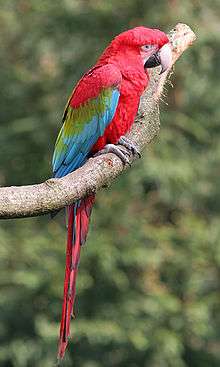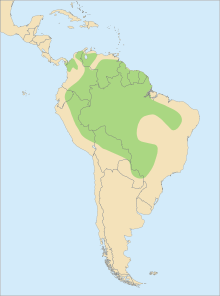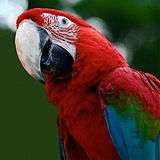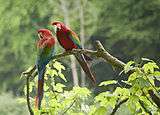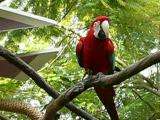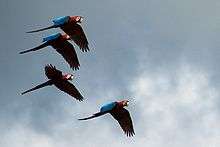Red-and-green macaw
The green-winged macaw (Ara chloropterus), also known as the red-and-green macaw,[2] is a large, mostly-red macaw of the Ara genus.
This is the largest of the Ara genus, widespread in the forests and woodlands of northern and central South America. However, in common with other macaws, in recent years there has been a marked decline in its numbers due to habitat loss and illegal capture for the parrot trade.
Description
The green-winged macaw can be readily identified from the scarlet macaw. While the breast of both birds are bright red, the upper-wing covert feathers of the green-winged macaw is mostly green but can occasionally sport a few yellow feathers above the band of green (as opposed to mostly yellow, or a strong mix of yellow and green in the scarlet macaw). In addition, the green-winged macaw has characteristic red lines around the eyes formed by rows of tiny feathers on the otherwise bare white skin patch; this is one of the biggest differences from a scarlet macaw to the casual viewer. Iridescent teal feathers are surrounded by red on the tail. If seen together, the green-winged macaw is clearly larger than the scarlet macaw as well.
In terms of length, this species is second only in size to the hyacinth macaw, the largest of the macaws. The red-and-green macaw attains a total body length of 90 to 95 cm (35 to 37 in) in adults.[3] Twelve adults were found to average 1,214 g (2.676 lb).[4] A weight range of between 1,050 and 1,708 g (2.315 and 3.765 lb) has been reported.[3] While its weight range is broadly similar to that of the hyacinth, the average weight of the red-and-green macaw is slightly surpassed by both the hyacinth and great green macaws, and amongst all living parrots additionally by the kakapo.[3][4]
Behavior
The green-winged macaw generally mates for life. The female typically lays two or three eggs in a nest made in a hole in a tree. The female incubates the eggs for about 28 days, and the chicks fledge from the nest about 90 days after hatching.[5]
Re-introduction programme
Aves Argentinas, a partner of BirdLife International is leading the re-introduction of the species in Argentina. The bird which has not been seen for some years and is listed as critically endangered in Argentina was released in Iberá Provincial Reserve (Spanish: Reserva Provincial Iberá) in the north-eastern province of Corrientes. The birds are from zoos and breeding centres in Argentina and were released in 2015.[6]
Gallery
| The upper body, showing the head and neck details |
| Four wild green-winged macaws flying in Peru |
|
References
External links
